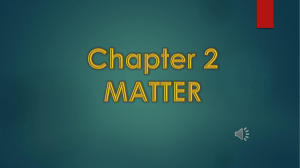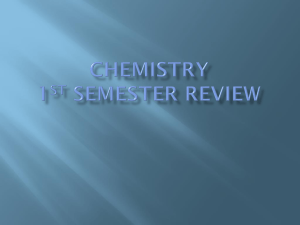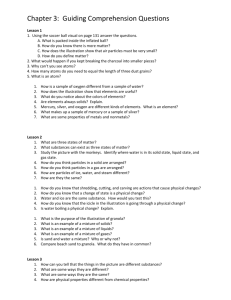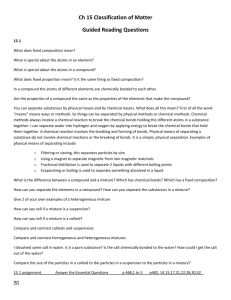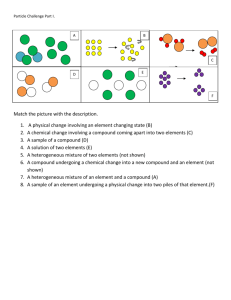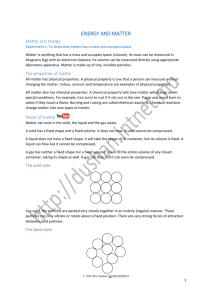Unit 1 Exam Review Questions (Answers Labeled A:_____) P/C
advertisement
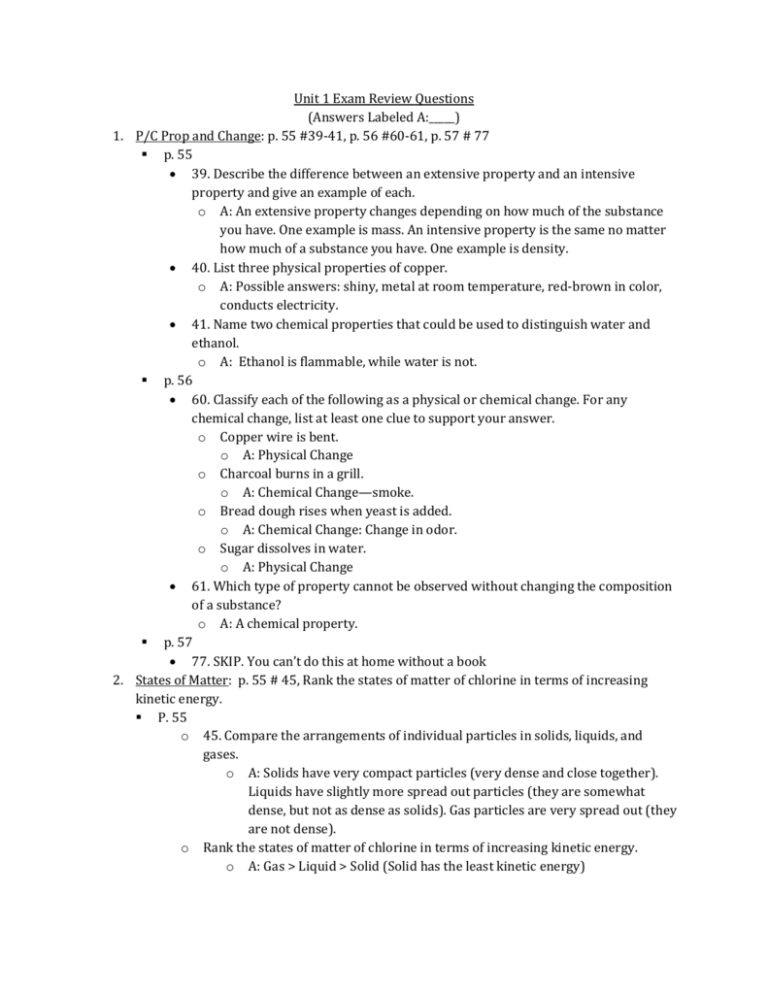
Unit 1 Exam Review Questions (Answers Labeled A:_____) 1. P/C Prop and Change: p. 55 #39-41, p. 56 #60-61, p. 57 # 77 p. 55 39. Describe the difference between an extensive property and an intensive property and give an example of each. o A: An extensive property changes depending on how much of the substance you have. One example is mass. An intensive property is the same no matter how much of a substance you have. One example is density. 40. List three physical properties of copper. o A: Possible answers: shiny, metal at room temperature, red-brown in color, conducts electricity. 41. Name two chemical properties that could be used to distinguish water and ethanol. o A: Ethanol is flammable, while water is not. p. 56 60. Classify each of the following as a physical or chemical change. For any chemical change, list at least one clue to support your answer. o Copper wire is bent. o A: Physical Change o Charcoal burns in a grill. o A: Chemical Change—smoke. o Bread dough rises when yeast is added. o A: Chemical Change: Change in odor. o Sugar dissolves in water. o A: Physical Change 61. Which type of property cannot be observed without changing the composition of a substance? o A: A chemical property. p. 57 77. SKIP. You can’t do this at home without a book 2. States of Matter: p. 55 # 45, Rank the states of matter of chlorine in terms of increasing kinetic energy. P. 55 o 45. Compare the arrangements of individual particles in solids, liquids, and gases. o A: Solids have very compact particles (very dense and close together). Liquids have slightly more spread out particles (they are somewhat dense, but not as dense as solids). Gas particles are very spread out (they are not dense). o Rank the states of matter of chlorine in terms of increasing kinetic energy. o A: Gas > Liquid > Solid (Solid has the least kinetic energy) 3. Elements, Compounds, and Mixtures: p. 55 # 53 (justify by drawing a particle diagram), #48, 50 P. 55 o 53. Classify the following materials as an element, compound, or mixture. Give reasons for your answers. o NaCl A: Compound—there are two elements bound together (Na and Cl) See PPT for the diagram o Salt Water A: Mixture—there is salt, and there is water, both of which are compounds. They are not chemically linked. See PPT for the diagram (NaCl and H2O) o Sodium A: Element—it is on the periodic table (symbol = Na) See PPT for the diagram (Na). 4. Separation Techniques: p. 41 #17, 19, Is the crystal that forms during crystallization “pure”? Why or why not? P.41 o 17. In general, when would you use filtration to separate a mixture? When would you use distillation to separate a mixture? o A: Filtration should be used when there are different sized particles (for example a solid mixed into a liquid or solids in a gas). Distillation should be used to separate anything with different boiling points (e.g. Salt and Water or Water and Alcohol). o 19. Give three examples of when you have separated mixtures at home. o A: Using a coffee filter, separating pasta from water, in an air filter (for your air conditioner) etc. o Is the crystal that forms during crystallization “pure”? Why or why not? o A: Yes, it is. It is all one compound (or element). When it forms, only the compounds that are identical to the original compound can stack onto the seed crystal and become part of the growing crystal. 5. Law of Conservation of Mass: p. 57 # 80, 86, p. 59 #11 P. 57 o 80. The wax seems to disappear as a candle burns. How can the law of conservation of mass apply to this reaction? o A: Even though the wax seems to disappear, no matter is destroyed. The mass that the candle loses becomes smoke (various gases) and moves into the atmosphere that way. The mass of the candle that you start with is equal to the mass of the candle that you end with plus the mass of all the gas that is lost (as smoke, etc.) o 86. When powdered iron is left exposed to the air, it rusts. Explain why the mass of the rust is greater than the mass of the powdered iron. o P. 59 o A: The iron reacts with oxygen in the air to form rust. This additional oxygen adds mass to the iron and is responsible for the difference in mass. 11. Magnesium metal burns vigorously in oxygen to produce the compound magnesium oxide. Use the law of conservation of mass to identify the masses labeled (a), (b), and (c) Mass magnesium (g) Mass oxygen (g) Mass magnesium oxide (g) 5.0 3.3 8.3 6.5 (a) 10.8 13.6 9.0 (b) (c) 12.5 31.5 o A: Adding the first two columns will give you the mass in the third column. For a: 10.8g – 6.5g = 4.3g For b: 13.6g + 9.0g = 22.6g For c: 31.5g – 12.5g = 19.0g
